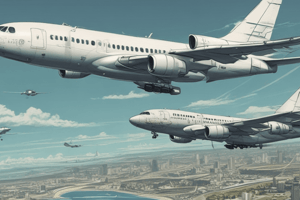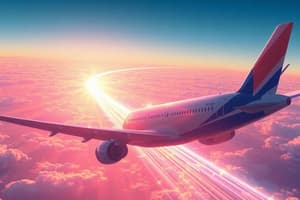Podcast
Questions and Answers
What are the four key areas that aviation systems encompass?
What are the four key areas that aviation systems encompass?
The four key areas are aircraft, air traffic management, airport operations, and regulatory frameworks.
Identify two types of aircraft and explain their primary purposes.
Identify two types of aircraft and explain their primary purposes.
Two types of aircraft are commercial and cargo. Commercial aircraft are used for transporting passengers, while cargo aircraft are designed for transporting goods.
What role does Air Traffic Control (ATC) play in air traffic management?
What role does Air Traffic Control (ATC) play in air traffic management?
Air Traffic Control (ATC) manages the safe and efficient movement of aircraft in the airspace.
List two key components of airport operations.
List two key components of airport operations.
Discuss the significance of Safety Management Systems (SMS) in aviation.
Discuss the significance of Safety Management Systems (SMS) in aviation.
How do technological advancements influence flight operations?
How do technological advancements influence flight operations?
What are Unmanned Aerial Vehicles (UAVs) and how are they relevant to modern aviation?
What are Unmanned Aerial Vehicles (UAVs) and how are they relevant to modern aviation?
Explain the focus on reducing carbon emissions in aviation.
Explain the focus on reducing carbon emissions in aviation.
Flashcards are hidden until you start studying
Study Notes
Overview of Aviation Systems
- Aviation systems consist of various components that work together to facilitate air travel and transportation.
- Key areas include aircraft, air traffic management, airport operations, and regulatory frameworks.
Components of Aviation Systems
-
Aircraft
- Types: Commercial, cargo, military, general aviation.
- Systems onboard: Navigation, communication, control systems.
-
Air Traffic Management (ATM)
- Ensures safe and efficient movement of aircraft in the airspace.
- Components:
- Air Traffic Control (ATC): Ground-based personnel managing aircraft movements.
- Flight Information Regions (FIRs): Designated areas of airspace for ATC services.
-
Airport Operations
- Facilities for aircraft takeoff, landing, and servicing.
- Key areas:
- Runways and taxiways: Infrastructure for aircraft movement.
- Terminals: Passenger services and baggage handling.
-
Regulatory Frameworks
- Governing bodies: Federal Aviation Administration (FAA), International Civil Aviation Organization (ICAO).
- Regulations cover safety standards, flight operations, and environmental considerations.
Safety and Security
- Safety management systems (SMS) are crucial for identifying and mitigating risks.
- Security measures include passenger screening, baggage checks, and cyber security for systems.
Technological Advancements
- Integration of automation and artificial intelligence in flight operations.
- Development of Unmanned Aerial Vehicles (UAVs) and drone technology.
Environmental Impact
- Focus on reducing carbon emissions and noise pollution.
- Initiatives for sustainable aviation fuels (SAF) and energy-efficient aircraft design.
Future Trends
- Growth in air travel demand and potential congestion in airspace.
- Innovations in urban air mobility (UAM) and electric vertical takeoff and landing (eVTOL) aircraft.
Overview of Aviation Systems
- Aviation systems are composed of multiple integrated components ensuring efficient air travel and transportation.
- Key areas encompass aircraft, air traffic management, airport operations, and regulatory frameworks.
Components of Aviation Systems
-
Aircraft
- Types encompass commercial, cargo, military, and general aviation.
- Onboard systems include navigation, communication, and control systems.
-
Air Traffic Management (ATM)
- Ensures safe and efficient aircraft movement within airspace.
- Key components include:
- Air Traffic Control (ATC): Personnel responsible for managing aircraft movements on the ground and in the air.
- Flight Information Regions (FIRs): Segmented airspace areas designated for ATC services.
-
Airport Operations
- Facilities designed for aircraft takeoff, landing, and servicing activities.
- Key elements include:
- Runways and Taxiways: Infrastructure essential for aircraft movement.
- Terminals: Areas designated for passenger services and baggage handling.
-
Regulatory Frameworks
- Major governing bodies include the Federal Aviation Administration (FAA) and the International Civil Aviation Organization (ICAO).
- Regulations regulate safety standards, flight operations, and environmental concerns.
Safety and Security
- Safety management systems (SMS) play a vital role in identifying and mitigating risks in aviation.
- Security measures include:
- Passenger screening
- Baggage checks
- Cybersecurity protocols for aviation systems
Technological Advancements
- Integration of automation and artificial intelligence significantly enhances flight operations.
- Development of Unmanned Aerial Vehicles (UAVs) and drone technology is advancing rapidly.
Environmental Impact
- There is an increasing emphasis on reducing carbon emissions and minimizing noise pollution.
- Initiatives are underway for sustainable aviation fuels (SAF) and the design of energy-efficient aircraft.
Future Trends
- An anticipated surge in air travel demand may lead to congestion in airspace.
- Innovations are emerging in urban air mobility (UAM) and electric vertical takeoff and landing (eVTOL) aircraft.
Studying That Suits You
Use AI to generate personalized quizzes and flashcards to suit your learning preferences.




